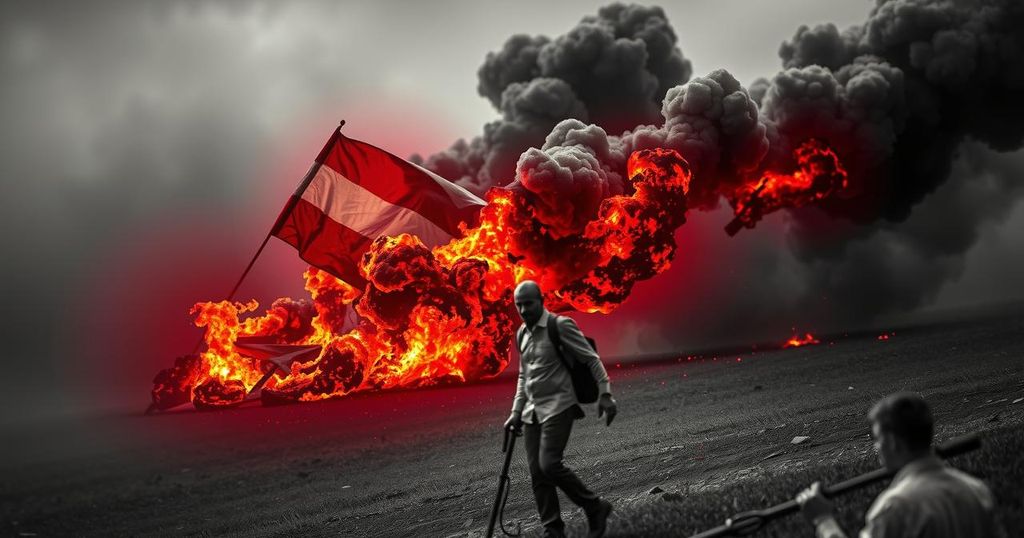The Fallout of Assad’s Regime: Implications for Russia and Iran
The recent turmoil in Syria presents concerns for Russia and Iran as Bashar al-Assad’s regime faces unprecedented challenges. Rebel forces have gained significant ground, undermining Assad’s authority and altering the dynamics of Middle Eastern politics. The involvement of external powers like Russia, distracted by the conflict in Ukraine, and Iran, focusing on Israel, further complicates the situation, leaving a vacuum created by a potential fall of Assad.
The recent upheaval in Syria marks a pivotal moment for the Middle East, particularly with the sway of influence held by Bashar al-Assad now in jeopardy. The relentless advance of rebel forces has left Assad’s authority profoundly weakened, as demonstrated by their bold incursion into Damascus, where they publicly desecrated images of his father, Hafez al-Assad, whose regime ruled with an iron fist. The implications of this chaos reach far beyond Syrian borders, signaling significant geopolitical shifts that jeopardize both Russia and Iran’s interests in the region.
For Russia and Iran, the consequences of Assad’s potential downfall are particularly dire. Over the course of the Syrian conflict, which began in 2011, both nations have provided crucial military support and resources to sustain Assad’s government. Syria functions as Russia’s primary ally in the Middle East, facilitating Moscow’s strategic foothold via naval and air bases that extend Russian influence throughout the region. Iran has similarly vested interests, as the Assad regime forms a vital link in the Shia crescent that stretches from Iran through Syria to Lebanon, challenging Sunni powers like Israel and Saudi Arabia.
Assad’s regime, which had appeared solid just weeks ago, faced a dramatic collapse due to escalating internal dissent and violent crackdowns on protests that spiraled into a civil war. While Iranian proxies, such as Hezbollah, played a role in propping up Assad, they, alongside Russian support, have been significantly hindered by distractions in other regional conflicts, most notably Russia’s ongoing war in Ukraine. The situation has only intensified with that conflict demanding Russian focus and resources, while Iran looks towards Israel amid rising tensions.
The confluence of these factors culminated in the recent audacious attack by Hayat Tahrir al-Sham, which deftly struck against a regime that appeared vulnerable due to both its military entanglements and internal strife. The group’s success amidst the chaos not only alters the dynamics within Syria but also reshapes the strategic landscape of the broader Middle East.
What the future holds remains uncertain amid the shifting allegiances and the multifaceted conflict involving proxy forces and regional politics. The situation reinforces the unpredictable nature of Middle Eastern geopolitics, where one event can catalyze significant changes in authority and influence.
The Syrian crisis, which has unfolded since 2011, has rewritten the political landscape of the Middle East. Bashar al-Assad’s regime faced extensive protests that escalated into a civil war fueled by sectarian divisions and influenced heavily by external parties, namely Russia and Iran. Moscow’s involvement was driven by strategic interests, as Syria provided a pivotal ally in the region, allowing military bases that extend its naval and air capabilities. Meanwhile, Iran leveraged its support of Assad to maintain a corridor for Shia influence across the Levant, which has security implications for Sunni powers in the region.
The recent developments in Syria signal a significant weakening of Bashar al-Assad’s authority, presenting legitimate concerns for Russia and Iran, both of whom have heavily invested in maintaining his regime. The successful strike by Hayat Tahrir al-Sham has profound implications for the geopolitical environment of the Middle East, potentially altering the balance of power as the focus of engaged powers shifts in response to regional conflicts. The outcome remains uncertain as the delicate fabric of alliances and hostilities continues to evolve with each passing day.
Original Source: www.abc.net.au




Post Comment